QUIZ 2
Performance Management
Performance Appraisal, Development, and Management
- Performance Appraisal
- Formalized means of assessing worker performance in line with certain established organizational standards
- Objective: Aim to see if workers are performing according to the organizational standards
- KPIs - Key Performance Indicators
- More specific and observable
- KRAs - Key Results Areas
- More broad
- Each working department has KRAs, while each position has KPIs
- It is considered a more traditional approach
- Necessary but not enough
- Performance Development
- Assessment of performance with the goal of providing feedback to facilitate improved performance
- More recent in terms of development
- Objective: If we find out that employees are not performing according to the established performance standards, developmental interventions are implemented
- They are given feedback along the way
- If they are not able to improve performance, then interventions such as training are practiced (one on one training, mentoring)
- It is not enough to just evaluate the performance
- Performance appraisal data may be used to inform decisions regarding punishments
- However, punishments (ex.: termination) should always be the last resort
- Feedback should be given in order for the employee to improve
- Without feedback, no efforts will be made
- Performance Management
- Incorporates appraisal and development to make performance-based administrative decisions and help employees improve
- Combines objectives of appraisal and development
Three-Step Appraisal Process
- Setting performance standards
- Before evaluating performance, standards must be set
- Employees must be aware of clearly defined performance standards
- Helps with goal setting
- Assessing the employee’s actual performance relative to these standards
- In HR, this is where performance appraisal instruments come in
- Providing feedback to the employee with the aim of helping them improve
- Performance appraisal and counseling
- After performance rating forms are answered, supervisors must identify the employee’s KPIs and KRAs, as well as areas for improvement
- There should be an Appeal mechanism
Purpose of Performance Appraisal
- Administrative decisions
- Basis for punishments (demotion and termination) and rewards (retention, promotion, pay raises)
- In an organization, people may be aiming for promotions or are still on probation (not certain if they will be retained)
- Without performance appraisals, where would we base these decisions?
- Cannot be judgment or favoritism based
- Not legally defensible
- Employee development and feedback
- Supervisors need to inform subordinates about expectations and how well the expectations are being met
- May identify the developmental interventions needed by the employee
- Cannot just terminate the employee without informing them of what they are lacking
- Offers a solution to their shortcomings in the workplace
- Companies can include semi annual goal setting, periodic coaching, and feedback sessions between employee and supervisor
- If performance appraisal is done annually, it may be problematic
- Not developmental
- Not much chance for the employee to improve their behavior; they may be forced to be removed
- If quarter annual performance appraisals cannot be afforded, it should be done at least twice a year
- Still provides opportunities for employees to make amends
- Supervisors should not always depend on formal, pen-and-paper performance appraisals
- Hot stove principle
- If an employee does not perform up to standards, do not wait for weeks to pass before giving feedback
- Feedback must be quickly given to address areas of improvement
- Hot stove principle
- If performance appraisal is done annually, it may be problematic
- Supervisors need to inform subordinates about expectations and how well the expectations are being met
- Criteria for research
- Job performance data can serve as the dependent/independent variable in other subjects being studied (eg., ergonomics, hiring better people, motivating employees
Evaluators of Performance
- Supervisors
- Most common source
- It is rare for companies to ask the other sources of information
- Responsible for the performance of the person being evaluated
- Observe end results (e.g., daily sales) but may not see every minute of an employee’s behavior
- While supervisors may see the end results, they do not see the process of doing
- Danger of bias for or against (negative or positive bias)
- Peers
- See actual behavior of the employee
- Observes their co-worker actually working
- Can result to open communication, cohesion, and reduced social loafing
- Employees tend to react worse to negative feedback from peers
- Subordinates
- Usually for developmental purposes; can improve manager’s performance
- Also known as upward feedback
- Uncovers
- Honest feedback from subordinates may be difficult to obtain out of fear over backlash from supervisor
- Subordinates prefer to give anonymous ratings
- Customers
- Customers can provide informal feedback through complaints or compliments towards employees
- They can also be asked to fill out formal evaluation cards
- Secret shoppers → customers who have been incentivized by a company to periodically evaluate a service they receive
- Service may not be consistent (ex.: fast food employees)
- There are peak hours and lean hours
- During lean hours, quality of service and products may be higher
- However, peak hours may cause employees to rush orders and therefore lessen quality control
- Customer evaluations should be more straight to the point
- Self-Appraisal
- Employee evaluates their own performance
- Cultural differences
- Countries such as the US, Mainland China, India, and Singapore may suffer from leniency errors (high evaluation ratings)
- Countries such as Japan, Korea, and Taiwan may suffer from modesty (lower evaluation ratings even though they deserve a higher
- Countries such as Japan, Korea, and Taiwan may suffer from modesty (lower evaluation ratings even though they deserve a higher self appraisal
- If appraisals are averaged from multiple sources, the self-appraisal usually isn’t included
- Then why do we still do self-appraisal?
- If average of the other sources has a discrepancy with their own evaluation, it may make them more aware of why they receive lower scores
- Possible self-entitlement?
- However, it is not always the employee’s fault
- Perhaps their roles and expectations were not clearly defined by their supervisor
- Role ambiguity
- If average of the other sources has a discrepancy with their own evaluation, it may make them more aware of why they receive lower scores
- Then why do we still do self-appraisal?
- May be more accurate if not used for administrative purposes
Focus of the Appraisal
- Trait-Focused Performance Dimensions
- Concentrates on employee attributes such as honesty, dependability, courtesy, etc.
- Provide poor feedback and thus will not result in employee development and growth
- Because traits are personal, employees may become more defensive
- It is better to focus on employee behaviors rather than traits
- May make the employee feel judged which would not motivate them to be better
- Be specific on the behavior you want to change
- Competency-Focused Performance Dimensions
- Concentrates on the employee’s knowledge, skills, and abilities
- Easier to provide feedback and suggest steps needed to correct deficiencies
- Skills can be improved
- Task-Focused Performance Dimension
- Organized by the similarity of tasks that are performed and includes several competencies
- Because supervisors are concentrating tasks that occur together, evaluating performance in other dimensions becomes easier to visualize
- Difficult to offer suggestions to correct deficiencies
- Where do employees lack in terms of tasks?
- Task focus examples
- Crime prevention, arrest procedures, court testimony, use of vehicle, radio procedures
- Goal Result-Focused Performance Dimensions
- Appraisal is organized based on the goals to be accomplished by the employee
- Makes it easier for the employee to understand why certain behaviors are expected
- Focuses on KRAs
- Helps remind the employee of the bigger picture
- A combination of the KPIs (looks into details) and KRAs (looks into goals) may be beneficial
Characteristics of Performance Criteria
- Theoretical Criterion
- Theoretical construct (definition) of what good performance is
- Actual Criterion
- The way in which the theoretical criterion is assessed or operationalized
- There is sometimes a problem when the actual criterion is not enough to measure the theoretical criterion (criterion deficiency)
- Results in criterion contamination
- Examples of Theoretical and Actual Criteria
Job | Theoretical Criterion | Actual Criterion |
Insurance salesperson | Sell insurance | Monthly sales |
Store clerk | Provide good customer service | Survey of customer satisfaction |
Teacher | Impart knowledge to students | Students’ achievement test scores |
- Criterion Contamination
- The part of the actual criterion that reflects something other than what it is designed to measure
- Can arise from biases in the criterion and unreliability
- Criterion Deficiency
- Means that the actual criterion does not adequately cover the entire theoretical criterion
- An incomplete representation of what we are trying to assess (insufficient content validity)
- Criterion Relevance
- The extent to which the actual criterion assesses the theoretical criterion it is designed to measure (construct validity)
- Criterion Complexity
- Criteria can become complex because jobs involve multiple tasks that can be evaluated from several perspectives
- Sometimes, dimensions of employee performance can be contradictory
- Ex.: quality dimension vs. quantity dimension of performance
- Ways to deal with criterion complexity
- Composite criteria approach: Combining individual criteria into a single score; finding the average
- Ex.: Attendance, professional appearance, work quality, work quantity
- Multidimensional approach: Individual measures are not combined
- Less concerned about the average, but more on the scores for each dimension
- In terms of creating developmental interventions, training may be given on the specific area of weakness identified
- Composite criteria approach: Combining individual criteria into a single score; finding the average
- Dynamic Criteria
- Variability of performance over time
- How can we account for the fact that performance changes during different periods of time?
- Makes the assessment difficult because the performance would not have stayed the same throughout the measurement of the time period
- Variability of performance over time
- Contextual Performance
- Extra, voluntary things employees do to benefit their co-workers and organization that must be considered in developing criteria for jobs
- Counterproductive work behaviors (negative) or organizational citizenship behaviors (positive)
- When we design performance appraisal instruments, should we include organizational citizenship behaviors?
- Not recommended
- If we do, we leave no room for OCBs → requires pay
- Would not be an OCB as it is no longer voluntary
- However, employees who enact OCBs should be rewarded accordingly (e.g., promotion)
- Not recommended
Rater Bias and Errors
- Horn Effect
- If an employee’s rating in one dimension is low, it may lead the evaluator to also rate them low in other unrelated dimensions
- Halo Effect
- If an employee’s rating in one dimension is high, it may lead the evaluator to also rate them high in other unrelated dimensions
- When the rater gives an individual the same rating across all dimensions despite differences in performance across all dimensions
- Happens when an evaluator allows a single attribute or an overall impression of an individual to affect ratings on specific qualities
- Peter Principle
- is a concept in management developed by Laurence J. Peter. It observes that people in a hierarchy tend to rise to “a level of respective incompetence.” Here’s how it works: Employees are promoted based on their success in previous roles until they reach a level where they are no longer competent. Skills in one job don’t necessarily translate to another. If a person is competent in their new role, they’ll be promoted again until they eventually reach a level where they’re incompetent. This leads to the inevitable outcome: "In a hierarchy, every employee tends to rise to their level of incompetence." So, in essence, the Peter Principle suggests that individuals keep getting promoted until they’re no longer effective in their positions.
- Similar-to-Me Error
- If the employee has more similarities to the evaluator, they are also more likely to receive better ratings
- Primacy Effect
- Rating is based on first impressions or performance in the first quarter
- Does not account for dynamic criteria
- Recency Effect
- Bases rating on the employee’s most recent work performance
- Fundamental Attribution Error
- The tendency to blame dispositional factors for negative attributes of the employee
- No effort to understand situational factors
- Ex.: Employee is always late → “they’re just lazy”
- Self-Serving Bias
- Evaluator attributes only the successes of the employee to themselves
- Self-Fulfilling Prophecy
- Expectations of the evaluator end up becoming a “self-fulfilling prophecy”
- Such expectations affect how the evaluator treats the employee, which contributes to the self-fulfilling prophecy
- Ex.: Employer thinks that an employee will not last long in the workplace, which results in them not prioritizing the employee (no one-on-one training, no positive feedback), thus resulting in the employee not lasting long in the company
- Distributional Errors
- Evaluator tends to rate everyone on the same rating scale regardless of their performance
- Leniency Errors: Evaluator rates everyone on the favorable end of the scale, not reflective of how employees are actually performing
- Does not differentiate between the good performers from those who are not
- May cause the good performers to become demotivated
- Does not help identify areas for improvement
- No developmental interventions are created and implemented
- Company goals may not be reached
- Does not differentiate between the good performers from those who are not
- Severity Errors: Evaluator rates everyone on the unfavorable end of the scale; strictness error
- Also leads to demotivation among employees
- Central Tendency Errors: Evaluator rates everyone on the middle of the performance scale
- Always “plays it safe”
- Does not identify the good performers from those who are not as good
- Leniency Errors: Evaluator rates everyone on the favorable end of the scale, not reflective of how employees are actually performing
- Evaluator tends to rate everyone on the same rating scale regardless of their performance
- Proximity Errors
- Occurs when the rating of one dimension affects the rating of another dimension that immediately follows it on the performance scale
- Ex.: Because the second dimension is physically located under the first, there is a tendency to provide the same score for both dimensions
- Contrast Errors
- Occurs when the performance rating of one person is influenced by the performance rating of the person evaluated before them
- Usually happens in graphic rating for each of the dimensions
- Pros: Easy to construct and usescales
- No established standards
- Tend to compare the performance one employee to another rather than comparing them to an organizational standard
- Low Reliability Across Raters
- Two people rating the same employee seldom agree with each other
- Happens because raters often commit rating errors, have different standards of good performance, and may see different behaviors behind performance
- Sampling Problems
- Recency Effect
- Infrequent Observation
- Cognitive Processing of Observed Behavior
- Observation of behavior: memory accuracy decreases over time; need for evaluation immediately after observation or take down notes
- Emotional state: amount of stress experienced by the supervisor affects their evaluation
- Bias
- Favoritism among employees
- Examples of Rater Bias and Error
- Personality: High conscientiousness → stricter in evaluations; High agreeableness → more lenient
- Closeness: Having a good relationship with the boss can positively affect appraisal
- Age: Younger evaluators may have more prejudice towards older employees
- Gender: Successful women are more likely to be penalized
- Reducing Rater Errors
- Rater Error Training: Raters are familiarized with rater errors and are taught to avoid these patterns
- Critics have pointed out that you might be replacing one error with another error
- Evaluators may be more conscious to avoid certain rater errors, despite the employee performing below standard
- Frame-of-Reference Training: Attempts to provide a common understanding of the rating task
- 360 Degree Feedback: Uses multiple perspectives for manager feedback; managers evaluate themselves, then are evaluated by peers, subordinates, and supervisors
- Easier said than done
- Time-consuming and requires a lot of follow-up
- Rater Error Training: Raters are familiarized with rater errors and are taught to avoid these patterns
- Rating Committees
- Formed after answering performance appraisal tools
- Review ratings and, in the process, may discover mistakes
- Composed of the employees’ immediate supervisors
- Discuss among themselves their reasons for the appraisals they gave for each of their subordinates
- “Calibration meetings”
- Usually done because multiple raters often see different facets of an employee’s performance
- Helps cancel out problems such as bias on the part of the individual raters
- Pros: Easy to construct and usescales
Six Points of a Legally Defensible Performance Appraisal System
- Perform job analysis to define dimensions of performance
- Should always be job-related and essential to the job
- Develop rating form to assess dimensions from prior point
- Train raters in assessing performance
- Have higher management review ratings and allow employees to appeal their evaluations
- If we are aware that people can be subjective and have thinking errors, there must be appeal mechanisms available for employees to contest ratings they have received
- Document performance and maintain detailed records
- Ex.: Critical incident reports
- Provide assistance and counseling to poor-performing employees prior to actions against them
- Perform job analysis to define dimensions of performance
Methods for Assessing Job Performance
- Objective Measures (“Hard” performance criteria)
- Quantitative in nature
- Counts of various behaviors (e.g., number of days absent from work) or the results of job behaviors (e.g., total monthly sales) that are easily quantified
- More observable because we are looking at specific counts
- What is acceptable?
- Ex.: In the number of units finished in a product, how many units were acceptable?
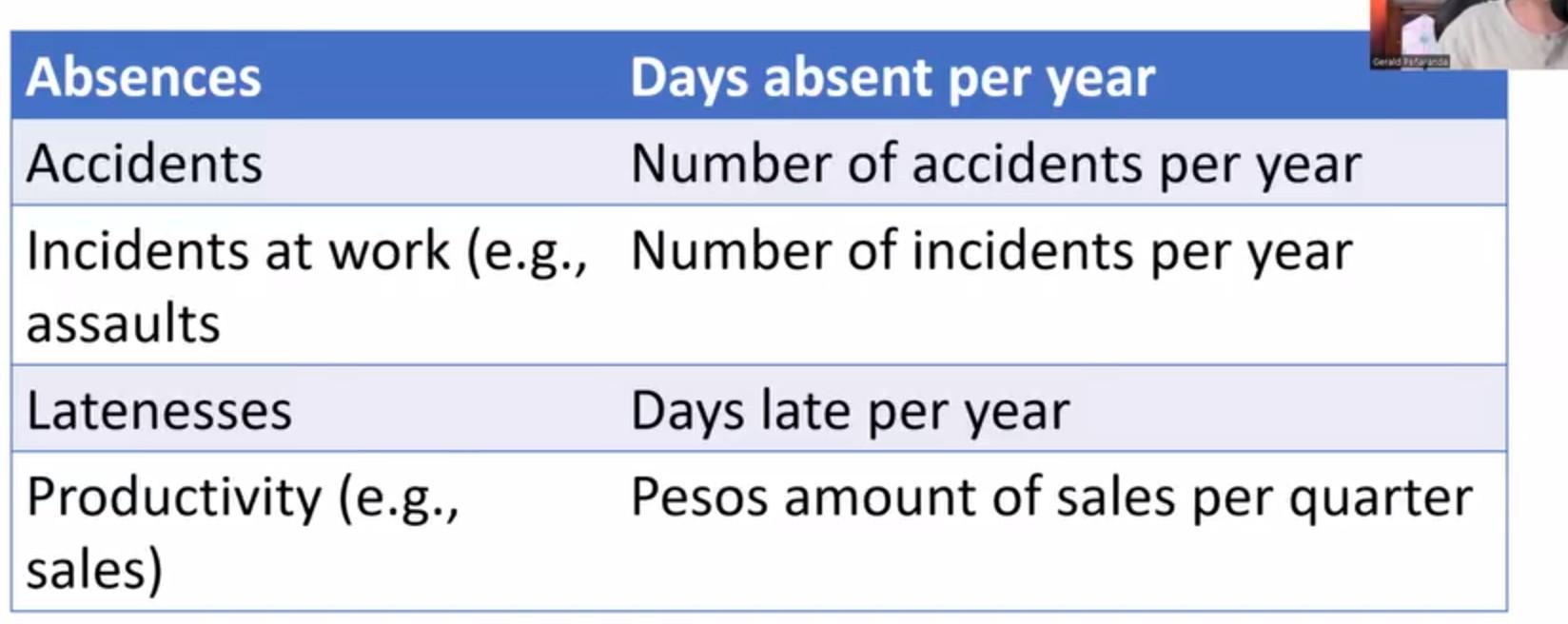
- Subjective Measures (“Soft” performance criteria)
- Ratings of people who should be knowledgeable about the person’s job performance, usually by supervisors
- Rely on the subjectivity of subject-matter experts
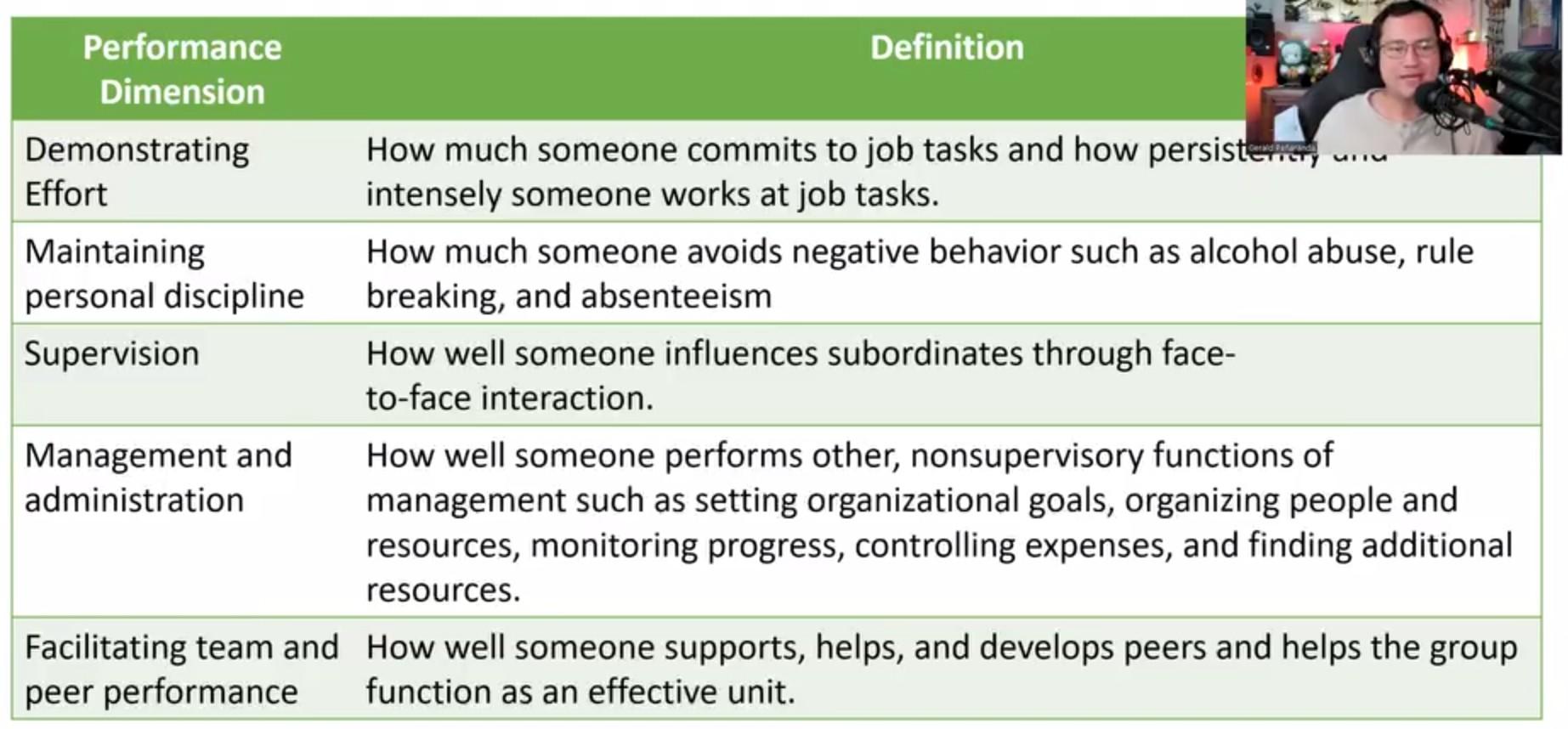
- Graphic Rating Scales
- Most commonly used rating scale
- Maximum subjectivity of raters
- No established organizational standards; no basis for scoring
- Assesses individuals on several dimensions of performance
- Focuses on the person’s performance (e.g., work quality or quantity) or their characteristics/traits (e.g., appearance, attitude, dependability, motivation)
- Consists of a multi-point scale that represents a continuum of performance from low to high
- Usually contains four to seven values
- Supervisor checks off a rating scale
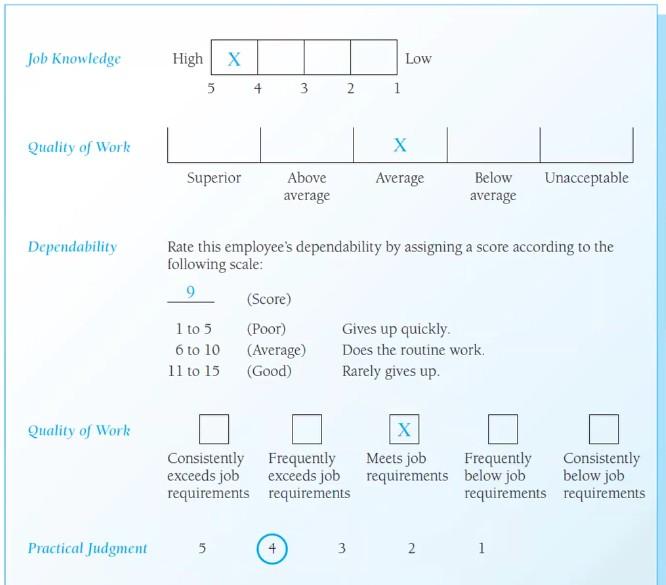 Cons: Susceptible to rating errors such as halo effect and leniency
Cons: Susceptible to rating errors such as halo effect and leniency
- Ex.: In the number of units finished in a product, how many units were acceptable?
- Employee Comparison Methods
- Individuals are compared with one another
- No established organizational standards
- Avodis concentration of ratings at one part of the scale caused by error
- Pros: Eliminates central tendency and leniency errors because raters are compelled to differentiate among people being rated
- Cons: Halo error is still possible, no defined performance standards
- Methods
- Rank order
- Rater ranks employees from high to low on a given performance dimension
- Still no organizational standards
- Rank order
- Not motivating to learn that you are the least or the worst as there is no organizational basis
- Person ranked first is regarded as the best and the person ranked last as the worst
- Pros: Easily used when there are only a few employees to rank
- Cons: Becomes tedious and even meaningless to rank order large numbers of people
- Paired comparison
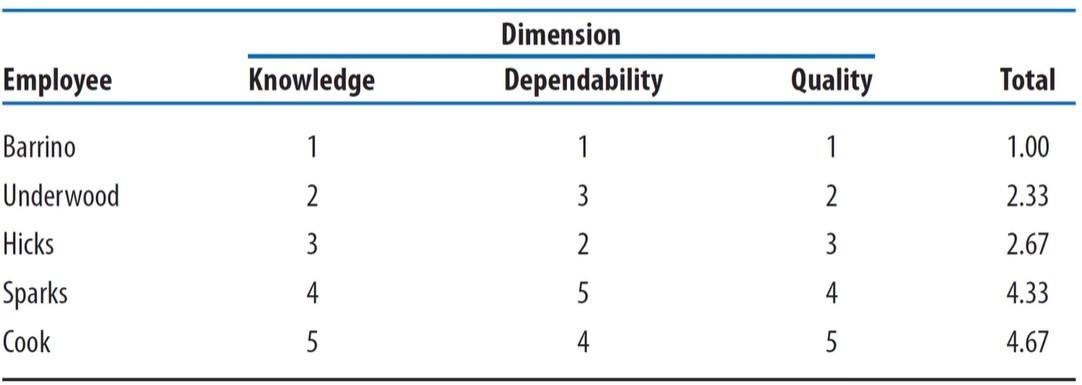
- Involves comparing each possible pair of employees and choosing one of each pair is the better employee
- Still no established organizational standards
- Typically used to evaluate employees on a single dimension
- The number of times each person was selected as the better of the two is tallied then people are ranked by the number of tallies they receive
- Pros: Best for relatively small samples
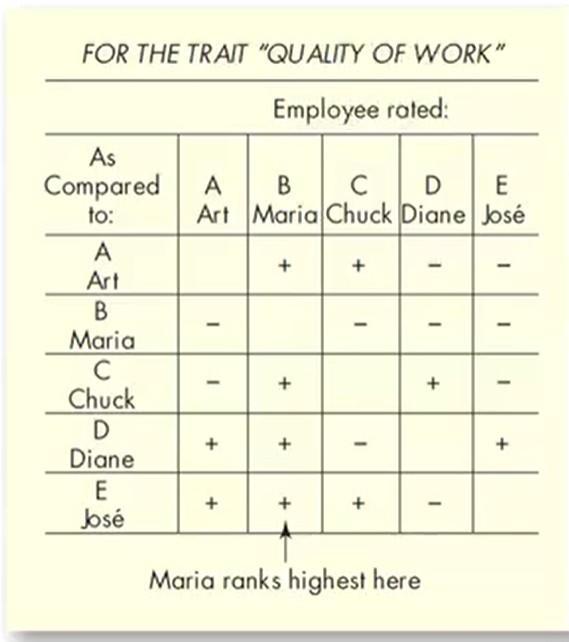 Cons: Becomes prohibitive with a large number of people (e.g., 100 employees = 4,950 separate comparison
Cons: Becomes prohibitive with a large number of people (e.g., 100 employees = 4,950 separate comparison- Forced distribution
- “Rank and yank” method
- Still no established organizational standards
- Based on the normal distribution and assumes that employee performance is normally distributed or follows the bell curve
- Using predetermined percentages based on the normal distribution, the rater evaluates an employee by placing him or her into one of the categories
- Does not need to be arbitrary
- Forced distribution
- Can also be computed statistically
- Employees who are put in the 10% category are usually terminated from the company
- Pros: Increases levels of organizational productivity every year, employee-comparison method of choice for large number of employees
- Cons: Very harsh, damages morale, considered by employees as harsh and least fair, assumes that employee performance is normally distributed although it is not always the case
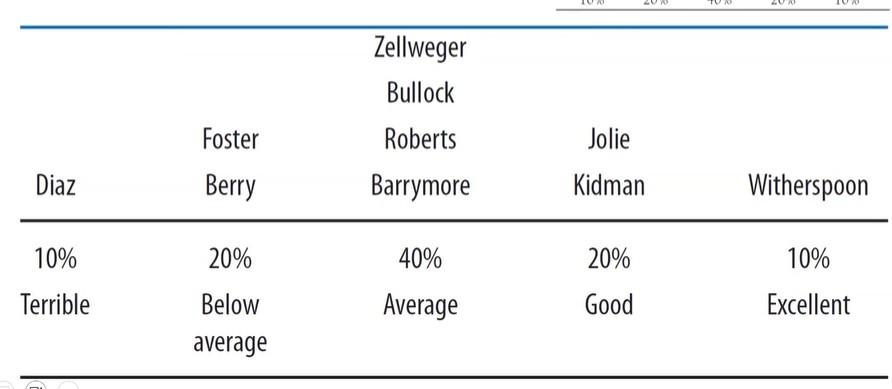
- Behavior-Focused Rating Forms
- Based on observable behaviors of the employee
- Four steps in developing behavior-focused rating forms
- Step 1: Perform job analysis to define job dimensions
- Step 2: Develop descriptions of effective and ineffective job performance from critical incidents
- Step 3: Have knowledgeable judges place descriptions into job dimensions
- Step 4: Have knowledgeable judges rate the effectiveness of the descriptions
- Critical Incident Reports
- All other behavior-focused rating forms started from this
- It is important to encourage supervisors to log critical incidents in a log book
- Formal accounts of employee performance that were observed by the supervisor
- Records in a logbook of poor and good performance
- May help counter infrequent performance appraisals within companies
- No numerical ratings
- Basis for developing other rating forms

- Basis for developing other rating forms
- Behaviorally Anchored Rating Scales (BARS)
- Performance is rated on a scale but the scales are anchored on behavioral incidents
- Rater chooses the behavior that is closest to describing the performance of the person in question
- Identify and define the dimensions of performance that you will tap
- Behavior must be observable from the perspective of the supervisor
- Certain behaviors are better than other behaviors
- Time-consuming but worth it
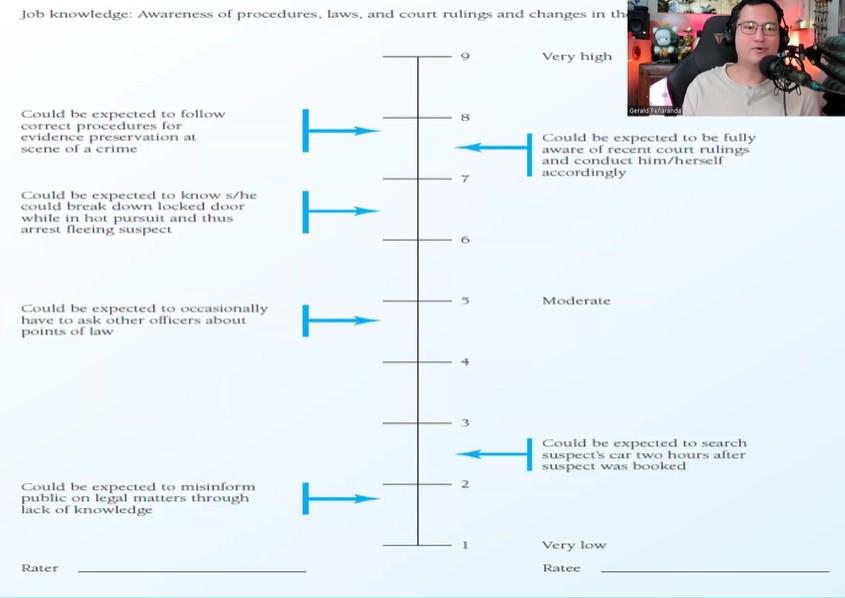
- Behavioral Observation Scale (BDS)
- How frequent is the behavior done?
- Contains items that are also based on critical incidents
- Final step is to do item analysis to detect the critical incidents that most influence overall performance
- Has content validity
- Mixed Standards Scale (MSS)
- Developed by having employees rate job behaviors and critical incidents on the extent to which they represent various levels of job performance
- For each dimension, a behavior or incident is chosen to represent excellent performance, average performance, and poor performance
Training and Development
Definition
- An organization's planned efforts to help employees acquire job-related knowledge (KSAOs), skills, abilities, and behaviors, with the goal of applying these on the job
- Systematic acquisition of skills rules concepts or attitudes that result in improved performance
- Goal
- For efficiency purposes; if employees are able to perform their job efficiently, then the company is profitable
- Increase an organization’s profits
Employee Orientation
- Also known as NEO (New Employee Orientation/On-boarding)
- On-boarding for new employees
- Procedure for providing new employees with basic background information about the firm
- Also to appreciate the company’s culture and values
- Role of HR Officer
- To plan and design the HR training
- Explains essential matters like working hours, benefits, vacations, discipline matters
- Introduces new employee to his or her new supervisor
- To plan and design the HR training
- Role of Supervisor
- Explains the organization of the department
- Familiarizes the new employee with the workplace by introducing them to their new colleagues and work environment
- Helps reduce first-day jitters
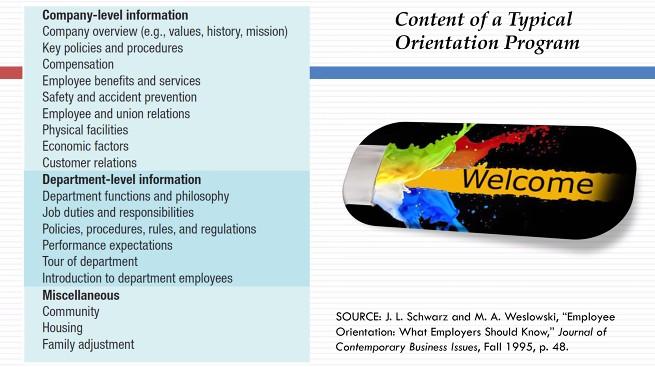
- Helps reduce first-day jitters
Diversity Training
- One of the newest forms of training
- Multinational companies are often diverse; employees must learn to work with different kinds of people without prejudice or bias
- DEI (Diversity, Equity, and Inclusion) programs are designed to change employee attitudes about diversity and develop skills needed to work with a diverse workforce
- More diversity = higher chances of conflict
- Attitude change: Increase participants’ awareness of cultural and ethnic differences, as well as differences in personal characteristics and physical characteristics
- Contact Hypothesis - meaningful interactions with diverse individuals help employees realize they must change their prejudicial attitudes, or at the very least, that people are more than their stereotypes
- Gain a deeper appreciation of the uniqueness of a person rather than categorizing them based on certain societal standards; breaking stereotypes
- Behavioral change: Teaches skills for constructively handling communication barriers, conflicts, and misunderstandings that necessarily arise when different people try to work together
- Example: Negative feelings assertion; expressing behaviors that you do not appreciate rather than harboring negativity, then suggesting an alteration in the behavior
- This includes avoidance of behaviors that intimidate others
Pre-Retirement Training
- Seminars are offered on such topics as making the retirement decision, retirement plans and options, investment and money management, and services and opportunities for retirees and seniors
- Many workers do not prepare well or prepare at all for retirement, according to research
5 Steps for Effective Organizational Training Programs
- A - Assess training needs
- Establish what are the training needs and if they are really training needs
- Can the need be better addressed by other organizational interventions?
- E - Establish training objectives
- D - Develop and test training materials
- Very time-consuming
- I - Implement training program
- Includes pilot testing and dry runs
- E - Evaluate training program
- Need to evaluate the effectiveness of the program so as to not waste the efforts of creating training programs
- Identify potential areas for improvement
Learning Management System
- Computer application that automates the administration, development, and delivery of training programs
- Ex.: Google Classroom, Prism, Canvas (Academic)
- Training and Development department is sometimes called LND (Learning and Development); broader and more encompassing
- Managers and employees can use the LMS to identify training needs and enroll in courses
- Uses of LMS
- Can monitor which employees are attending the training blocks they are required to attend
- Can evaluate the effectiveness of the training program
- Can create the training content
- LMS can make training programs more widely available and help companies reduce travel and other costs by providing online training
- LMS can be linked to the organization’s performance management system to plan for and manage training needs, training outcomes, and associated rewards together
Determining Training Needs
- Training Needs Assessment
- Determines if training is the solution to the problems of the company; we cannot assume that all problems of the company can be addressed by training
- Unproductivity may not be caused by an employee's lack of competence but by other factors such as compensation, company culture, work environment, etc.
- The first step in developing an employee training system
- Process of evaluating the organization, individual employees and employees’ tasks to determine what kinds of training are necessary
- Three types
- Determines if training is the solution to the problems of the company; we cannot assume that all problems of the company can be addressed by training
- Organizational Analysis
- Purpose: To determine organizational factors that either facilitate or inhibit training effectiveness
- Focus: Goals the organization wants to achieve, the extent to which training will help achieve these goals, the organization’s ability to conduct training, the extent to which employees are willing and able to be trained
- Answers the question: What is the context in which training will occur?
- Answers the question of whether the organization is prepared for training
- Does the company have the budget?
- What is the attitude of the decision-makers towards the training programs?
- Are they supportive of training?
- Do they see it as an unnecessary expense?
- What is the attitude of the people you will train towards training?
- Did they have negative experiences in the past?
- Do they think it is a hindrance to their work
- Concerns other factors such as timing
- Remember: Employees are pulled out of work to participate in the training program
- Part of costs is employee’s compensation (the losses caused by training)
- Depending on the industry, there is a right and wrong time to train
- Ex.: Auditing firms
- There are “peak seasons” where employees are too overworked to train
- What managers should do to support training
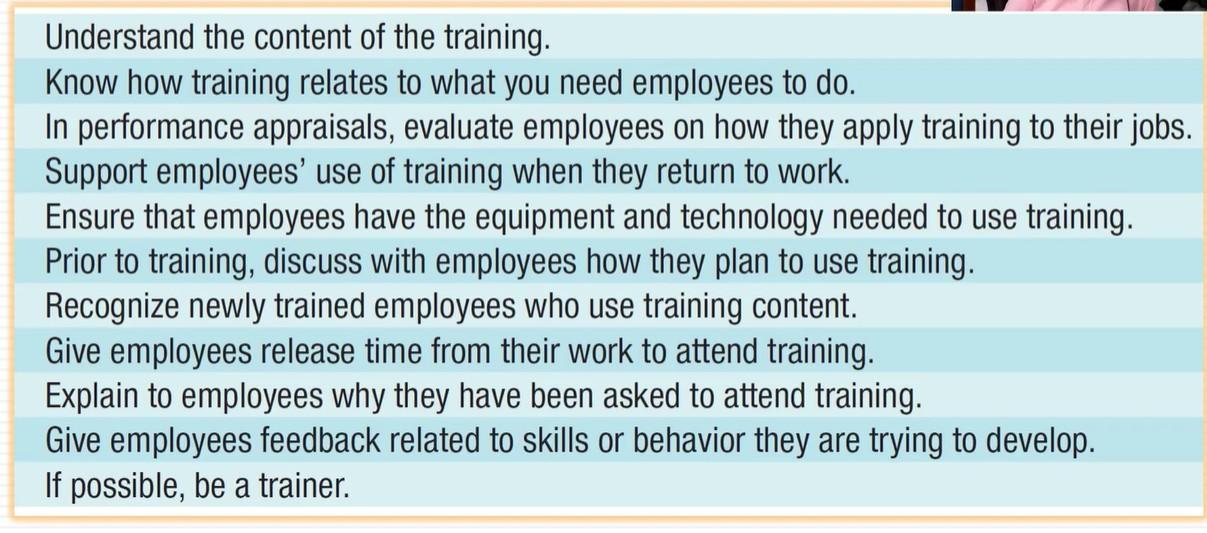
- There is a learning curve required in order to become proficient in what was learned during training
- Managers must be in the loop regarding the training program to support those who underwent training
- Managers and supervisors can be trainers themselves, considered as SMEs in their field
- Task Analysis
- Needs to understand the nature of the job in order to design a training program that will equip the trainees with the skills necessary to perform the job
- What are the tasks or responsibilities included in a particular position?
- Usually done for newly created jobs with no job description
- Purpose: To identify the tasks to be performed by each employee, the conditions under which the tasks are performed, and the competencies needed to perform the tasks under the identified conditions
- Answers the question: What are the requirements for performing the tasks?
- Methods: Interviews, surveys, observations, and task inventories
- Is easy to conduct and does not take much time if job descriptions are written in a detailed manner
- Performance Analysis
- Usually done for existing positions
- Wants to establish whether there is a performance gap
- Is there a gap between the expected level of performance versus the actual performance?
- Ex.: Medical representatives – must meet a monthly quota of PHP250,000, but in reality, they only sell PHP 100,000 on average (Identified performance gap)
- If we perform a training program, will it close the gap?
- Performance appraisal results are often a source of data
- Identifies weaknesses and strengths
- Surveys, interviews, skill/knowledge tests, and critical incidents are other methods to conduct this analysis
- Purpose: To verify if there is a performance deficiency and to determine whether the employer should correct such deficiencies through training or other means
- Answers the question: Who needs training?
- Demographic Analysis
- Challenges us to look into the demographic profile of the employees and decide what kind of training programs are suited for those demographic groups
- Purpose: To determine the specific training needs of various demographic groups, such as men and women, certain ethnic minorities, and workers of different age groups
- Answers the question: What kinds of training do specific demographic groups need?
- Purpose: To determine the specific training needs of various demographic groups, such as men and women, certain ethnic minorities, and workers of different age groups
- Challenges us to look into the demographic profile of the employees and decide what kind of training programs are suited for those demographic groups
- Causes of Needs Assessment
- Legislation (new laws that change certain practices in the industry)
- Lack of basic skills
- Poor performance
- New technology
- Customer requests
- New products
- Higher performance standards
- New jobs
- Customer dissatisfaction
- Reduce scrap
- Improve quality
Designing Training Programs
- Planning the overall training program includes:
- Setting performance objectives
- Creating a detailed training outline
- Choosing a program delivery method
- Verifying the overall program design with management
Training Aim
- Vision
- Talks about the future state of affairs for an organization
- Ex. “We are the number one…” “We are the leading…”
- Mission
- Talks about the “road” to get to the “destination” (vision)
- What qualities do we need to have to achieve our goal?
- Training aim talks about the big picture
- Is applicable for the entire training program
- Provides a general statement of intent
- How will the participants be different after going through the training?
- Ex.: “To help the interpersonal skills for hotel receptionists”, “To increase line managers knowledge and understanding of their responsibilities for health and safety”
Instructional Objectives
- The first step in the design process is to write learning objectives
- Learning Objective: “the baby steps needed to cross the river”
- Don’t want it to be a hit and miss; requires preparation
- Should be practical given financial and time constraints
- Should specify in measurable terms what the trainee should be able to accomplish after successfully completing the training program
- Ex.: “The technical service representative will be able to adjust the color guidelines on this HP officejet all in one printer copier within 10 minutes according to the device’s specifications
Components of a Learning Objective
- Performance
- Should describe observable behaviors that the participants will be able to do as a result of the training
- Make use of specific action verbs that are not subject to interpretations
- Unacceptable words: understand, know, believe, remember, learn
- Not observable or measurable
- Ex.: “The technical service representative will be able to adjust the color guidelines on this HP officejet all in one printer copier within 10 minutes according to the device’s specifications”
- Condition
- The circumstances under which the participant will be performing the activity
- Also describes the equipment, supplies, and job aids
- Includes the work setting and any given information used to direct the action
- Ex.: “The technical service representative will be able to adjust the color guidelines on this HP officejet all in one printer copier within 10 minutes according to the device’s specifications”
- Standard
- The level or degree of proficiency that it is necessary to perform the task or job successfully
- Indicates the quality of the performance
- May involve speed, accuracy with a margin of error, maximum number of mistakes permitted, productivity level, or degree of excellence
- “Using brochures and desk-top charts [condition], customer service representatives will answer [performance] all customer questions about standard products and services [standard]”
- “Managers will write [performance] a two-page, error-free request proposal [standard] following the proposal format introduced in the business writing workshop [condition]”
Training Design
- Transfer of training
- A concept dealing with whether training is applied in the work setting
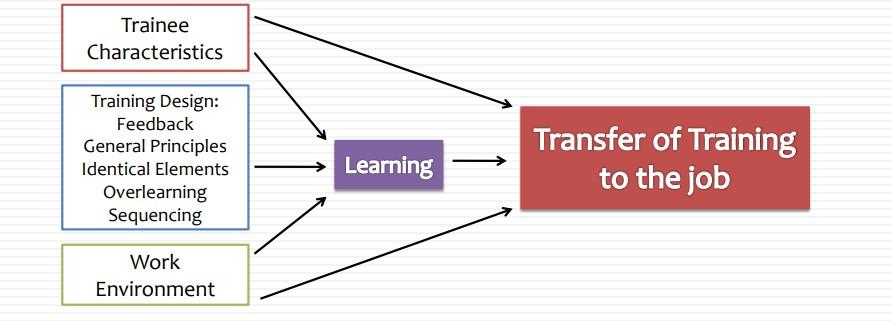
Trainee Characteristics
- Individual differences in ability and motivation are important factors in learning
- Abilities: Not everyone has the same ability to learn a given task, and training must recognize these differences
- Attitude and motivation: By giving rewards for successful completion and making the training interesting to the trainers, participants can be more motivated
Design Factors that Affect Transfer of Training
- Feedback
- Should be given to the trainees so that they can tell if they are learning the correct material
- General principles
- This section should teach why something is done
- Identical elements
- The responses in training situation are identical to the job situation
- The trainees will not be immediately integrated into the assembly line
- Overlearning
- Giving the trainees practice beyond what is necessary to reach a criterion and achieve automaticity
- Automaticity - muscle memory
- Avoid effortful processing of information
- A microskill is taught multiple times for the trainee to automatically process the skill
- Giving the trainees practice beyond what is necessary to reach a criterion and achieve automaticity
Deciding on Training Methods
- On-Site Methods
- Conducted where the employees are actually working
- Not in a training room, but on the job
- Ex.: OJT, vestibule, job rotation, practicum
- Off-Site Methods
- Can be done in a conference room or online
- Conducted away from the actual workplace
- Ex.: Lectures, audio-visual instructions, behavior modeling, simulation techniques, programmed instruction

Training Methods
- Lecture
- Commonly used training method
- Advantages
- Economical
- Can allow many participants to attend a single lecture, saves time for the trainer
- Economical
- Disadvantages
- If the lecture is lengthy, it can be boring for participants
- In order to counter this, lecturettes can be used instead
- Shorter and more digestible
- Activities can also be incorporated into the lecture
- Breaks the monotony of the lecture
- Lecturer must incorporate their own ways to make the lecture more interesting
- Making appropriate jokes
- Relating stories of true experiences into the lecture
- If the training is whole day, do not purely use lecture
- In order to counter this, lecturettes can be used instead
- If the lecture is lengthy, it can be boring for participants
- Case Study
- Advantages
- Presents trainee with a written description of an organizational problem
- Living Case
- Gives trainee a realistic case study that reflects a problem that the organization is currently experiencing
- The ideas proposed by the trainees to solve the organizational problem may be beneficial to the company
- Participants will be tasked to analyze the problem and then brainstorm suggestions to practically solve the issue at hand
- Allows diagnosis of realistic cases and presentation of proposed solutions
- Advantages
- Audio-Visual Instruction
- Recorded, electronic presentation
- Ex.: Online tutorials
- Advantages
- Self-paced learning, especially if skills are being taught
- Trainees can fast forward or rewind the video as they please
- Economical
- Tutorials can be uploaded to the LMS of the company
- No need to pay the trainer every time the program is being ran
- Recorded, electronic presentation
- General Tip ⚠
- The trainer should be familiar with the general proposal of the company re: the training program, whether it is on-site, online, or live
- If recorded lecture, it should be clear in the contract how many times the tutorial will be used by the company
- If it will be used many times, you may ask for higher pay as a trainee
- Role Playing
- Having trainees assume roles of specific persons in a realistic situation
- Can trigger spirited discussions; develops sensitivity to the feelings of others
- Used when teaching people skills/soft skills
- Ex.: How to handle irate customers, teaching assertiveness
- Because we are trying to transfer the “know-how” on how to deal with other people, role playing is more appropriate
- Training is usually about how to supervise, coach, or mentor properly
- The idea is to switch roles
- Trainee may play the role of the mentor, while trainer plays the role of the mentee
- Ex.: Trainee first plays the role of the irate customer, then they can play the role of the manager trying to address concerns of the irate customer
- Helps trainee develop insight and empathy on both ends
- If playing irate customer, you develop an understanding of why they may feel dissatisfied
- If playing manager, you develop an understanding of how to address their dissatisfaction
- The idea is to switch roles
- Trainer gives feedback and input regarding the process
- Behavior Modeling
- Differentiating B.M. and R.P.
- Remember: Albert Bandura and the Bobo Doll Experiment ⚠
- Children were made to observe adults who were acting aggressively towards Bobo doll
- Bandura wanted to measure if the children observing the aggressive behavior will follow similar behavior
- Remember: Albert Bandura and the Bobo Doll Experiment ⚠
- Having trainees watch someone perform a task and then having them model what they have seen
- Lecture is sometimes not enough; there needs to be a demonstration of the skill being learned
- Advantages
- High level of feedback
- Trainer must give trainee advice and feedback along the way
- Provides practice of new skills
- High level of feedback
- Differentiating B.M. and R.P.
- On-The-Job Training
- Having a person learn the job by actually doing it
- Ex.: Practicum
- Advantages
- High level of skills transfer
- Person with job experience and skills guides trainee in practicing job skills at the workplace
- High level of skills transfer
- Types
- Apprenticeship
- A work-study training method that teaches job skills through a combination of OJT and classroom training
- More suited for jobs requiring practical skills or blue collar jobs
- Internship
- OJT learning sponsored by an educational institution as a component of an academic program
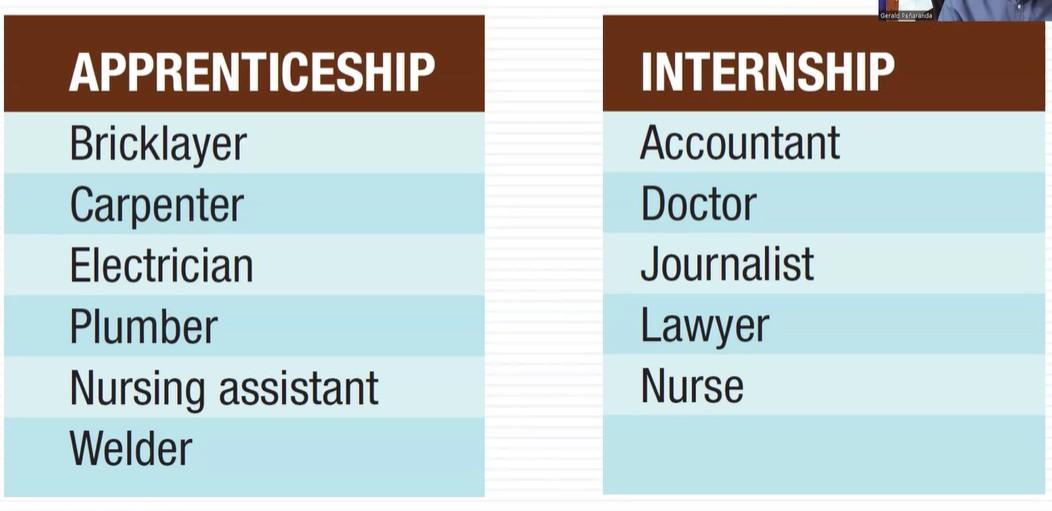
- OJT learning sponsored by an educational institution as a component of an academic program
- Apprenticeship
- Having a person learn the job by actually doing it
- Simulation
- Represents a real-life situation with trainees making decisions resulting in outcomes that mirror what would happen on the job
- Advantages
- Identical elements
- Safe
- Provides risk-free environment for trainees to learn
- Ex.: Army; virtual reality training are given to enlisted soldiers to give them experience in a simulated war zone to prevent potential harm in a real environment
- Ex.: Pilot; flight simulators
- Vestibule Training
- Simply means a separate room or a room adjacent to the actual workplace
- Trainees learn on the actual or simulated equipment they will use on the job but are trained off the job
- Advantages
- Used when it’s too costly or dangerous to train employees on the job
- Also contains identical elements in order to ensure transfer of training
- Disadvantages
- Expensive
- Need for separate machines and equipment in the vestibule
- Expensive
- Internet-Based Training
- Training can be done via synchronous or asynchronous online courses
- Was most prevalent during the pandemic
- Certain certification programs can also be taken online
- Needs to have assessments at the end of the online module to show competencies that are demonstrative of what was learned from the course
- Advantages
- Can be done through the company’s own intranet or from online training vendors
- Training can be done via synchronous or asynchronous online courses
- Computer-Based Training
- Computer is not necessarily connected to the internet
- Audio-visual course materials and instructions are placed in a computer
- Ex.: CDs in a computer
- Mobile Learning
- Delivering learning content on demand via mobile devices such as cellphones, laptops, and tablets
- Using the LMS of the company, trainees can download the training materials onto their smartphones
- Other Methods


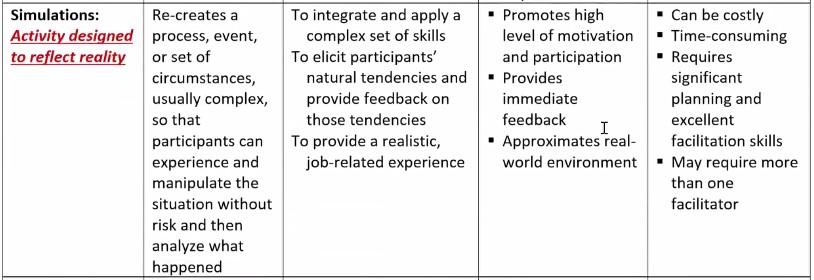

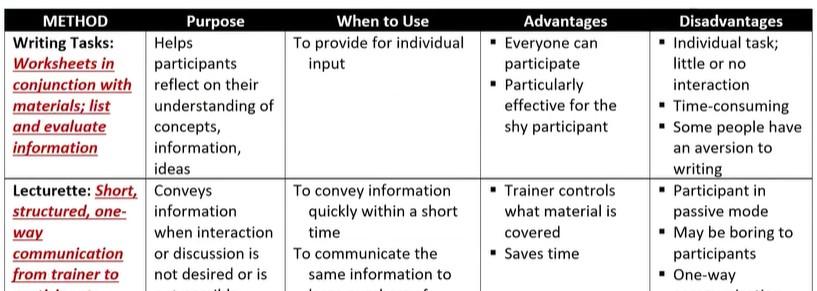
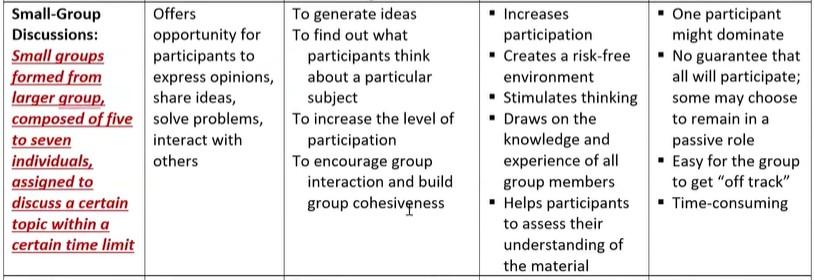

Use of Instructional Methods
- There’s a trend where companies usually look down on courses that were conducted purely online
- However, this is beginning to change, especially as a product of what was realized during the pandemic
- Organizations have learned that it is possible to design blended learning courses (combination of F2F and online methods)
Developmental Interventions
- Mentoring
- Special kind of work relationship, usually involving people who are tenured employees and someone who is new and trying to build competence
- The more experienced one offers career guidance, counseling, emotional support, and serves as a role model to the less experienced one
- Mentor does not only transfer technical skills; goes beyond
- (+) Helps the mentee develop careers in the company
- (+) Proteges have better job performance, quicker promotion, better job attitudes, and less turnover
- Acknowledges that tenured employees will eventually reach retirement age
- With this in mind, they would be able to transfer some of their talents to newer employees
- Executive Coaching
- Usually, the executive coaches are coming from a third-party organization that offers coaching
- High level executives are paired with a consultant who serves as an executive coach to help them improve performance
- Builds up soon-to-be managers and executives, but they lack some people skills
- Can be directive
- Crucial to pick an experienced and well-seasoned executive coach
- (+) Coach might work with the executive for an extended period of time, providing continual advice and feedback
Employee Career Development Programs
- Career development systems typically offer a variety of programs, including career counseling, courses in career planning, workshops that provide tools and techniques for helping employees manage their careers
- Might help individuals set career goals and develop a plan for getting the type of training and education necessary to meet those goals
- May also assist in finding jobs for employees who are about to be laid off
Delivery of the Training
- Presentation Skills
- Trainers should learn how to maintain comfortable eye contact with their participants
- Conveys interest in the trainees in what they are doing and how they are receiving the training
- Scan the room and focus on different participants
- NOT staring; do not make the other person uncomfortable and maintain an appropriate social distance
- Use gestures effectively
- Gestures must only emphasize certain important points
- Should not be used after every word; can be distracting
- Don’t read your presentation
- If presentation software is used, don’t put all the content in the slides
- Purpose of visual aids is to remind the trainer what to cover or discuss
- Prone to losing the interest of the trainees
- Don’t hide behind the podium
- It is not a conference
- Trainers must go near the participants, as some may be hesitant to ask questions
- Need to monitor each trainee in a non-threatening way; try to observe their performance and provide feedback on the spot
- Trainers should learn how to maintain comfortable eye contact with their participants
- Use a conversational style
- Trainers must be familiar with the profile of the participants (e.g., age, positions in the company, educational background)
- Presentation may include too many technical jargon that participants may not understand
- Objective of the training is to make sure the trainees learn as much as possible
- Be confident
- Being conscious of one’s tendency to use filler words and making efforts to minimize them
- Make sure to speak at an appropriate volume
- Avoid bragging about oneself
- Speak at a pace that is neither too fast or too slow
- Avoid swearing or offensive remarks, as well as demeaning other individuals or organizations
- Make the presentation interesting
- Incorporate a variety of activities
- Since training programs usually involve adult learners, provide opportunities for them to share about their experiences
- There must be balance for chances to share
- When answering questions, repeat, paraphrase, don’t bluff
- Do not assume that you are always right
- If the trainer is not sure that they understood the participants’ questions correctly, don’t be afraid to clarify
- Don’t force humor
- Must be mindful of the nuances in humor
Evaluating the Training
- Training Evaluation
- A training program is not complete until its effectiveness has been evaluated
- Evaluation: A piece of research that determines whether the program had achieved its intended effects
- Based on the TNA, were the training needs addressed?
5 Steps for Training Evaluation
- Set the criteria for the evaluation
- Criteria: Standards of comparison
- 2 Levels
- Training-Level
- Concerned with abilities learned and applied by people at the end of training in the training environment itself rather than on the job
- Is more shallow between the two
- Aims to find out if the trainees learned something after the training program
- Training-Level
- Ex.: Teaching assertiveness - conduct a pre-test and post-test; After the training, did their scores increase?
Limitations: it is likely that the knowledge they learned does not actually transfer to the job
- Performance-Level
- Concerned with the person’s performance on the job rather than the training setting, i.e., transfer of training
- When the trainees come back from the training program, will they be able to apply what they have learned?
- Kirkpatrick’s 4 Levels of Training Evaluation
- Level 1: Reactions Criteria
- Measures the impressions of trainees, including their assessments of the program’s value, the amount of learning they received, and their enjoyment of the program (evaluation rating surveys given to trainees immediately after sessions or workshops)
- Asks if trainees liked the training, the facilitator, the food, accommodations, etc.
- “One pager” given at the end of the training
- Criticisms: Too subjective, may become a popularity contest
- Despite its criticisms, there are still valuable insights to be gained from Level 1
- Helps improve the next run of the training program
- Ex.: Trainees may feel dissatisfied with instructional methods (lack of handouts); can be adjusted in the next training session
- Limitations: Does not measure learning or ability to apply learning on the job, cannot measure changes in attitudes or beliefs
- Categories: End-of-session evaluation form should include content, materials, instructional methods, trainer, environment, logistics, recommendations
- Format: Two-choice questions with room for explanation or comments, short answers, complete the sentence, ratings, rankings, checklist
- Level 1: Reactions Criteria
Level 2: Learning Criteria
- Measures the amount of learning that has taken place (examination at the end of training)
- “Extent to which participants change attitudes, improve knowledge, and/or increase skills as a result of the training”
- Tests: Give both pre-test and post-test to get a more accurate picture of what the participants have learned
- In inferential statistics, use T-test for dependent means
- Same group of participants for both pre-test and post-test
- Aims to compare scores
- Observation: Trainers can watch participants practicing and applying skills, tools, and techniques during the session
- Interviews: After training, interview participants and ask them what they learned from the lesson
- Level 3: Behavior Application Criteria
- Measures the amount of newly learned skills displayed once trainee has returned to the job (performance appraisal, observation methods)
- “How has the training affected the way participants perform on the job?”
- Challenges: Time-consuming and costly; requires good organizational and follow-up skills/processes
- Trainees must be given ample time to adjust and apply what they have learned; learning curve
- If the T&D department has low manpower and the staff are spread out in different branches, it may be difficult to check on them and observe
Will need the support of supervisors and managers; inform them of the competencies learned from the program
- Methods: Observation of employees back on the job, interviews with those affected by the training participant, surveys, and control group to compare results
- Time Considerations: Enough time for the behavior change to take place could be 3-6 months after attending the training
- Level 4: Results Criteria
- Measures the outcomes that are important to the organization, such as increased trainee work output as expressed by production rates, sales figures, or quality of work (cost-benefit analysis, tracking, operational data)
- What was the impact of the training on certain practical aspects of the business?
- Did sales increase?
- Did the quality of work improve?
- Refer to the needs and baseline data collected from the TNA (Ex.: low production outputs (need) → must show an increase in production)
- Critical Success Factors: Production output, sales, operating costs, customer satisfaction, quality standards, safety record, turnover rate, absenteeism, employee grievances, employee satisfaction, budget variances, promotions
- Limitations: Time-consuming, costly, and difficult (many variables come into play after the participant leaves training)
- Calls for certain skills from the evaluator, especially if the target is ROI (return on investment)
- Select a design for the study
- Design: The structure of a study that specifies how data is collected
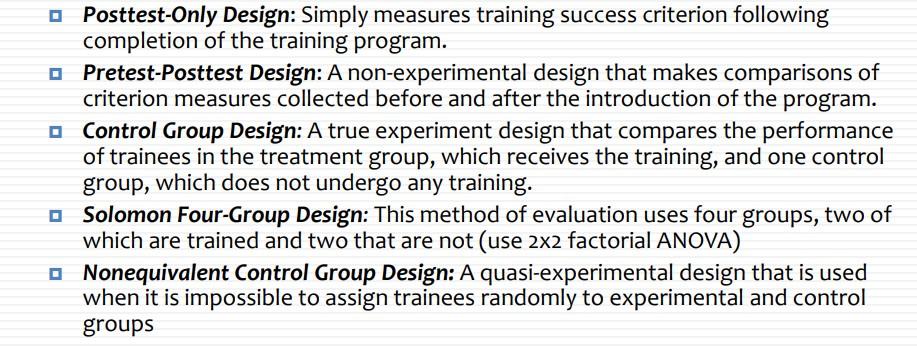
- Design: The structure of a study that specifies how data is collected
- Pretest-Posttest Design
- A series of performance measures are taken before and after the training program, and are compared for possible improvement
- Can be used to assess the amount learned in the training itself or the amount of change in behavior back in the job
- A practical design to use in organizations
- Inferential statistics method: T-test for dependent means (repeated measures)
- A major drawback is the difficulty of attributing changes to the training itself rather than events in the organization
- Control Group Design
- Used to compare employees who receive training to equivalent employees who have not been trained
- Control group: Not given training
- Experimental group: Given training
- After experimental group completes their training, the performance of both groups are compared through a test or how they actually perform a task
- Inferential statistics method: T-test for independent means
- Comparison between two subgroups of employees indicates the effects of training
- This design is more difficult to use in an organization because it is not always possible to assign employees at random to the two groups
- Is an improvement of pretest-posttest when you wish to determine the effects of training
Helps control for the possibility that it was something other than training that caused the changes you observed in employees
- Solomon Four-Group Design
- A method of program evaluation using two treatment groups and two control groups
- Combines pretest-posttest and control group designs
- Inferential statistics method: 2x2 factorial ANOVA
- Aims to address the limitations of the first two designs
- Four groups in the design
- A treatment group with both pre-intervention and post-intervention measurements (aka pretest and post-test)
- Control group with both pretest and post-test measurements
- A treatment group with only the post-test measurement
- A control group with only the post-test measurement
- Solomon Four-Group Design
- Select measures to assess the criteria
- Criterion determines to a great extent what sorts of measures can be used to assess it
- Examples
- Reaction Criteria: A questionnaire that asks for employees’ reactions
- Learning Criteria: Knowledge test to determine what has been learned for knowledge-based training, or role-play and simulation for skills-based training
- Performance Criteria: Measuring trainee behavior or results in the job setting rather than training
- Collect the data for the study
- Poses many practical problems such as uncooperative people
- Best possible design should always be planned ahead
- Modifications might have to be made during the study based on the problems encountered while it is being conducted
- Analyze and interpret the data
- Data from evaluation studies are interpreted through inferential statistics
- If all four steps have been executed well, it is possible to reach a confident conclusion about the effectiveness of the training program
- Training must be effective at both levels (training and performance levels) to consider the program effective
Employee Compensation
Definition
- All forms of pay or rewards going to employees and arising from their employment
- Benefits are part of compensation
- Two main components
- Direct financial payments: Pay in the form of wages, salaries, incentives, commissions, and bonuses
- Wage: pay by the hour (no work, no pay)
- Salary: fixed payment
- Indirect financial payments: Pay in the form of financial benefits such as insurance
- Direct financial payments: Pay in the form of wages, salaries, incentives, commissions, and bonuses
Types of Financial Rewards in the Workplace
- Membership and Seniority Based
- Rewards employees on the basis of being part of the organization and years rendered
- Ex.: government employees
- Assured pay on the 15th and 30th of the month, paid time off
- Organizations try to pay extra to those who stay longer (Seniority-Based)
- Way to encourage employees to stay with the company
- Ex.: Salary increase every year
- Advantages
- Guaranteed wages may attract job applicants
- Seniority-based rewards reduce turnover
- Disadvantages
- No guarantee that it motivates job performance
- Promotes complacency
- Discourages poor performers from leaving
- “Golden handcuffs”; tie people to the job because of generous benefits that generate continuance rather than affective commitment
- Some organizations offer early retirement programs to counter this
- Helps them save money
- Less experienced employees = less pay
- Job Status Based
- Rewards employees on the basis of the status or worth of the jobs they occupy; includes job evaluation and status perks
- Basis is competition
- In order to be promoted to high status jobs, one must be competitive
- Employee is given benefits that other lower-ranking employees are not permitted to receive
- Job Evaluation
- In order to say that a job deserves more compensation compared to another, job evaluation must be conducted
- Systematically rating the worth of jobs within an organization by measuring their required skill, effort, responsibility, and working condition
- Rewards employees on the basis of being part of the organization and years rendered
- Performance Based
- Rewards employees on the basis of high levels of performance—you earn more when you produce more, and you earn less when you produce less
- Pay-for-Performance
- Applicable to people whose productivity is measured by numbers (quantitative)
- Ex.: Number of products sold
- The incentives are based on objective performance measures such as sales and productivity; also known as earnings-at-risk (EAR)
- Ex.: Number of products sold
- Applicable to people whose productivity is measured by numbers (quantitative)
- The incentives are based on objective performance measures such as sales and productivity; also known as earnings-at-risk (EAR)
- Merit Pay
- Applicable to people whose productivity is measured by the quality
- Requires goal setting
- Did their performance improve on the performance appraisal instrument used by the company?
- The incentives are based on subjective performance measures such as such as performance appraisal scores; good technique for jobs in which productivity is difficult to measure
- Sample Rewards
- Promotion-based pay increase, status-based benefits (larger offices, company-paid vehicles, representation allowance)
- The improved job title is a reward in itself; entails bragging rights to some degree
- Ex.: Compensation Specialist → Compensation Manager
- Advantages
- Encourages being competitive and to work harder in order to earn the promotion
- Tries to maintain internal equity
- Minimizes pay discrimination
- Motivates employees to compete for promotions
- Disadvantages
- Encourages hierarchy, which may increase costs and reduce responsiveness
- More hierarchy = more expensive
- Higher positions usually do not accept that they do not receive higher pay
- Reinforces status differences
- Some cultures value equality
- Some companies aim for a flatter, leaner organization with fewer levels
- Motivates job competition and exaggerated job worth
- Competency Based
- Encourages hierarchy, which may increase costs and reduce responsiveness
- Rewards employees on the basis of their assessed competencies (skills, knowledge, etc.) and whether they actually use those in their current job duties
- Usually requires that employees attend training programs
- Once attended, it does not matter if the skill set is immediately used on the job; they will be compensated nonetheless
- Aims to prepare the workplace for the eventuality for when they need to use those skills later on
- Building a multiskilled company
- Ex.: Microsoft
- Once attended, it does not matter if the skill set is immediately used on the job; they will be compensated nonetheless
- Skill-based Pay
- A more specific variation of competency-based rewards in which people receive higher pay based on their mastery of measurable skills
- Samples: Pay increase based on competency; skill-based pay
- Advantages
- Motivates employees to learn new skills
- Tends to improve quality with multiskilled employees
- Disadvantages
- Subjective measurement of competencies
 Skill-based plans are expensive because employees spend more time learning new skills
Skill-based plans are expensive because employees spend more time learning new skills
- Performance-Based Rewards
- Gainsharing
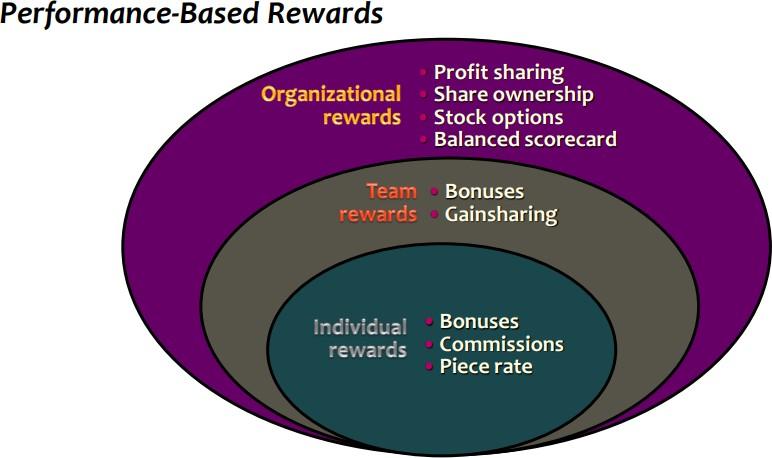 A team-based reward that calculates bonuses from the work unit’s cost savings and productivity improvement
A team-based reward that calculates bonuses from the work unit’s cost savings and productivity improvement- Implementing austerity measures (saving up on utility bills)
- There must be baseline data
- There is a target of cost savings per department
- If this target is met, the department splits the amount saved
- Profit Sharing
- An organization-based reward that pays bonuses to employees on the basis of the previous year’s level of corporate profit
- 13th month pay is required in the law; becomes part of the entitlement
- But if the company performs well, the company can produce 14th month and 15th month pay
- Stock Option
- A reward system that gives employees the right to purchase company stock at a future date at a predetermined price
- Employee Stock Ownership Plan (ESOP)
- A reward system that encourages employees to buy company stock at special price
- Helps alter the psychology of employees
- Before owning shares of stock, they may think of themselves as just an employee
- Their self-perception may improve; thinking that they are “part owner” of the company → motivates them to perform better
- Piece Rate
- Pay is given based on how many items the employee was able to finish in a day
- Gainsharing
- Advantages
- Motivates task performance
- Attracts performance-oriented applicants
- Organizational rewards create an ownership culture
- Profit sharing may avoid layoffs during downturns because of its variability
- Disadvantages
- If purely PFP, it may be financially burdensome to the workers
- Despite the strengths of an employee, there may be unforeseen circumstances that affect job performance (e.g., COVID-19, economic recession)
- Ex.: Bus drivers - no basic pay; their wages are based on whether they exceed their target number of passengers
- Results in overloading the bus, which puts the public in danger
- Compensation should not be purely PFP
- Suggestion: Fixed pay and performance rewards
- Despite the strengths of an employee, there may be unforeseen circumstances that affect job performance (e.g., COVID-19, economic recession)
- May weaken job content motivation
- May distance reward giver from receiver
- May discourage creativity
- Tends to address symptoms, not underlying causes, of behavior
- If purely PFP, it may be financially burdensome to the workers
Improving Reward Effectiveness
- Link rewards to performance
- It should be clear that rewards are linked with their performance
- Better performers should be rewarded more than poor performers
- Use objective performance measures
- Rely on multiple sources of information
- Reward soon after the performance occur
- Use large enough dose (bonus rather than pay increase) so that employees experience positive emotions when they receive the reward
- Ensure that rewards are relevant
- Align rewards with performance within the employee’s control
- Use team rewards for interdependent jobs
- Ensure that rewards are valued
- Do not make false assumptions about what employees want: ASK THEM!
- There are generational differences when it comes to incentives
- Watch out for unintended consequences
- If there are changes in the compensation system, pilot project before applying across the organization
- Helps identify what areas need to be fine tuned
- Avoids negative consequences on entire organization
- If there are changes in the compensation system, pilot project before applying across the organization
Competitive Strategy and Compensation
- Aligned reward strategy
- Role of Employer
- Create a bundle of rewards—a total reward package—specifically aimed at eliciting the employee behaviors the firm needs to support and achieve its competitive strategy
- Needs to be competitive
- Cannot be surpassed by competitors in the same industry
- May result in employees leaving for competitors
- Role of HR/Compensation Manager
- Write the policies in conjunction with top management, in a manner such that the policies are consistent with the firm’s strategic aims
- Must conduct salary surveys, ensure that policies are consistent with the strategies
- Compensation is not the job of the finance department; it is the job of the HR department
- Role of Employer
There is usually a compensation manager
Equity and Its Impact on Pay Rates
- The Equity Theory of Motivation
- We look at job inputs and what we get in return
- Includes our efforts, education, credibility, etc.
- We tend to have a comparison other
- It is possible for an employee who is receiving high salary to still be unhappy, compared to an employee who is not receiving as much, depending on the rational calculation of input-output ratio in relation to their comparison other
- Ex. Manager with 60k salary may still have grievances against employees with lower salary
- If manager with same position has salary of 70k, employee may start to question themselves and why they aren’t receiving the same amount
- Ex. Manager with 60k salary may still have grievances against employees with lower salary
- Employees are strongly motivated to maintain a balance between what they perceive as their contributions and their rewards
- States that if a person perceives an inequity, the person will be motivated to reduce or eliminate the tension and perceived inequity
- We look at job inputs and what we get in return
- Four Forms of Equity
- External Equity
- How a job’s pay rate in one company compares to the jobs pay rate in other companies
- Ex.: Mercury Drug vs. Watsons; Jollibee vs. McDonald’s
- Internal Equity
- How fair the jobs pay rate is when compared to other jobs within the same company
- Ex.: Accountant vs. engineer in the same compan
- Individual Equity
- The fairness of an individual’s pay as compared with what his or her co-workers are earning for the same or very similar jobs within the company, based on everyone's performance
- Ex.: Both employees are supervisors but they have different salaries
- Procedural Equity
- The perceived fairness of the processes and procedures used to make decisions regarding the allocation of pay
- Ex.: If an employee is expecting a salary increase and they were not given what they expected, are they given a chance to appeal this decision to the company? Are the decision-makers objective or are they biased?
- External Equity
- Methods to Address Equity Issues
- Salary surveys
- To monitor and maintain external equity
- If there are no salary surveys, the company cannot find out if they are still competitive with other companies in the same industry
- Job analysis and job evaluation
- To maintain internal equity
- Job analysis helps identify which positions have more responsibilities compared to others
- Job evaluation helps determine which positions require more compensable factors
- Performance appraisal and incentive pay
- To maintain individual equity
- In relation to comparison other
- Communications, grievance mechanisms, and employees’ participation
- To help ensure that employees view the pay process as transparent and fair (procedural equity)
- Are decisions communicated properly?
- Are employees able to air out grievances? Are they consulted about these decisions?
- Salary surveys
Establishing Pay Rates
- Step 1: Salary survey
- Aims to identify competitors to compare the wage rates
- Does not need to establish what exactly is being paid for each position
- Companies may not be willing to share such information
- Benchmark job can be identified
- A job that is used to anchor the employer’s pay scale and around which other jobs are arranged in order of relative worth
- Aimed at determining prevailing wage rates
- A good salary survey provides specific wage rates for specific jobs
- Formal written questionnaire surveys are the most comprehensive, but telephone surveys and newspaper ads are also sources of information
- A job that is used to anchor the employer’s pay scale and around which other jobs are arranged in order of relative worth
- Step 2: Job evaluation
- Why is the salary of one position more expensive than the other?
- Establishes compensable factors for every position
- Compensable Factor: a fundamental, compensable element of a job, such as skills, effort, responsibility, and working conditions
- Does the position require a higher educational requirement?
- Does it need a wider skill set?
- Does it have more responsibilities?
- More compensable factors = more pay
- Compensable Factor: a fundamental, compensable element of a job, such as skills, effort, responsibility, and working conditions
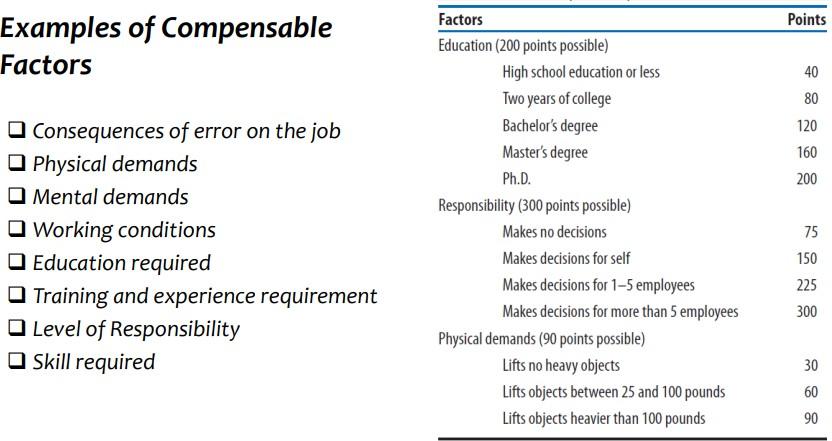 A systematic comparison done in order to determine the worth of one job relative to another
A systematic comparison done in order to determine the worth of one job relative to another- Four steps in Job Evaluation using the Point Method
- A panel of SMEs determines the compensable factors for the job
- The panel judges the degree to which each job has each compensable factors
- The point for the factors are summed for each job to provide a total score
- Plotting the actual salaries for each job against the point totals for each job
- More compensable factor points = higher pay
Comparable Worth
- Involves the issue of closing the gender pay gap
- The jobs do not need to be the same, but if they are comparable, their pay should be the same
- The requirement to pay men and women equal wages for jobs that are of comparable (rather than strictly equal) value to the employer
- Seeks to address the issue that women have jobs that are dissimilar to those of men and those jobs often consistently valued less than men’s jobs
- Factors lowering the earnings of women
- Women’s starting salaries are traditionally lower
- Salary increases for women in professional jobs do not reflect their above-average performance
- Sexism in performance appraisal
- In white-collar jobs, men change jobs more frequently, enabling them to be promoted to higher-level jobs over women with more seniority
- In blue-collar jobs, women tend to be placed in departments with lower-paying jobs
Payroll Salary Compensation and Benefits in the Philippines
- The Labor Code of the Philippines, otherwise known as Presidential Decree No. 442, governs all employee-employer relations, their rights and obligations.
- Wage and wage-related benefits
- Minimum Wage
- All regions in the Philippines have varying minimum wages
- Different costs of living in each region
- Metro Manila has higher cost of living compared to Bicol region (for example)
- Regional Wage Boards - decides on the minimum wage per region, and is comprised of representatives from the business sector and the labor sector
- The Wage Rationalization Act, Republic Act No. 6727, sets the minimum wage rates applicable per region, province and industry sector
- Minimum wage may vary depending on the number of employees and gross-sales of an enterprise and its industry sector
- Minimum daily wage in NCR is: Non-agricultural (Php 610.00)
- This is divided into 8 hours (Php 76 per hour)
- Lunch break is unpaid
- Agricultural, retail/service, and manufacturing (Php 573.00)
- All regions in the Philippines have varying minimum wages
- Minimum Wage
- Outside of Metro Manila, the minimum daily wage varies depending on the region
- Overtime
- Goes beyond the standard 8 hours of work
- The minimum wage is based on a work week of 40 hours or 8 hours per day
- The daily 60-minute mandatory lunch break is not included in the 8-hour workday and is not compensated
- Overtime pay rates vary depending on when the overtime work takes place: regular workday, holiday, rest day, or night (between the hours of 10pm to 6am)
- Overtime Rates
- Regular workday: plus 25% of the hourly pay rate
- Rest day, regular/special holiday: plus 30% of the hourly rate on said day
- Premium Pay
- Refers to the additional compensation required by law to be paid to employees for work performed on non-working days, such as rest days and special days
- Premium Pay Rates
- Rest day or special holiday - additional 30% of his daily basic rate
- Rest day which is also a special holiday - additional 50% of his daily basic rate
- Regular holiday which is also an employee’s rest day - additional 30% of the regular holiday rate of 200% *only applicable to employees covered by the holiday-pay rule
- Double pay + 30% additional
- The “no work, no pay” principle applies during special non-working days and such other special days as may be proclaimed by the President of the Philippines
- Workers who are not required or permitted to work on these days are, therefore, not entitled to any compensation
- Special working holidays
- For work performed, an employee in the Philippines is entitled only to his basic rate
- No premium pay is required since work performed on said days is considered work on ordinary working days
- Holiday Pay
- The Labor Code requires the payment of an employee’s daily basic wage for all non-working regular holidays
- 12 regular holidays (Republic Act No. 9492)
- New Year’s day
- Maundy Thursday
- Good Friday
- Araw ng Kagitingan
- Labor Day
- Independence Day
- National Heroes’ Day
- Eid’l Fitr
- Bonifacio Day
- Eidul Adha
- Christmas Day
- Rizal Day
- Rate Example
- If work is accomplished on a regular holiday (up to 8 hours), an employee is entitled to at least twice (200%) of his basic wage
- Overtime
Double pay
- If the holiday corresponds to a scheduled rest day, the employee is entitled to an additional 30% based on his regular holiday rate of 200%
- Night Shift Differential
- For work done between the hours of 10pm to 6am, employees are entitled to Night Shift Differential (NSD), which represents an additional 10% to the regular wage for each hour of work performed
- The government only stipulates the minimum rate, but employers may choose to increase the NSD rate
- Service Charges
- The recently enacted Republic Act No. 11360 and its Implementing Rules and Regulations mandating that 100% of service charges collected by establishments be given to all covered employees
- The collected service charge will be split amongst all employees
- Old legislation used to give a portion of the SC to the employers for any breakages (e.g., broken plates, etc.)
- Service charges are collected by most hotels and some restaurants, night clubs, cocktail lounges, among others
- Double pay
- If the holiday corresponds to a scheduled rest day, the employee is entitled to an additional 30% based on his regular holiday rate of 200%
- Double pay + 30% additional
- Night Shift Differential
- For work done between the hours of 10pm to 6am, employees are entitled to Night Shift Differential (NSD), which represents an additional 10% to the regular wage for each hour of work performed
- The government only stipulates the minimum rate, but employers may choose to increase the NSD rate
- Service Charges
- The recently enacted Republic Act No. 11360 and its Implementing Rules and Regulations mandating that 100% of service charges collected by establishments be given to all covered employees
- The collected service charge will be split amongst all employees
- Old legislation used to give a portion of the SC to the employers for any breakages (e.g., broken plates, etc.)
- Service charges are collected by most hotels and some restaurants, night clubs, cocktail lounges, among others
- Exceptions to Coverage of Benefits granted under the provisions on Overtime, Premium, Holiday, Night Shift Differential Pays and Service Charges
- These lines of work DO NOT need to be paid the benefits stated above, but if the company can afford to, they still can
- Government employees
- Workers of retail and service establishments regularly employing less than 10 workers
- Still considered a start-up business
- Managerial employees and officers or members of a managerial staff
- House helpers and persons in the personal service of another
- Workers who are paid by results/output
- Field personnel if they regularly perform their duties away from the office or place of business
- These lines of work DO NOT need to be paid the benefits stated above, but if the company can afford to, they still can
- Service Incentive Leave
- Every employee who has rendered at least one (1) year of service (whether service is continuous or broken) is entitled to a Service Incentive Leave (SIL) of five (5) days with pay
- SIL may be used for sick and vacation leave purposes
- The unused SIL at the end of the year can be converted into cash using the salary rate at the date of conversion
- It is the employer’s prerogative to grant additional vacation leave
- Service Charges
- Parental Leaves
- Parental Leaves
- The Labor Code of the Philippines covers three different types of parental leaves: maternity leave, paternity leave and solo parent leave
- The gynecological leave and leave for women and their children who are victims of violence are the other leaves considered under the labor code
- Maternity Leave (R.A. 11210)
- Parental Leaves
- 105 paid leave days(live birth)
- 60 paid leave days (miscarriage, emergency termination of pregnancy)
- 7 days transferable to father (optional)
- 30 days additional leave without pay (optional)
- 105 plus 15 paid days leave for qualified solo female parent
- Solo mother must get an ID from the MSWD to certify that they are a single parent
- Paternity Leave
- 7 paid leave days, with full pay, for the first 4 deliveries of his legitimate spouse with whom he is cohabiting
- Solo Parent Leave
- 7 paid leave days every year (not convertible to cash) to attend child’s milestones like birthday, communion, graduation)
- May request for flexible working schedules
- Gynecological Leave
- A woman employee shall be entitled to a special leave benefit of two (2) months with full pay based on her gross monthly compensation following surgery caused by gynecological disorders
- Must present medical certificate from physician
- Victims of Violence Leave
- Must present formal complaint raised to the barangay in order to avail of this leave
- 13th Month Pay
- Each year, a 13th month pay is required to be given to all rank-and-file employees
- Managerial employees are exempted from this
- By law, this benefit must be paid in full before December 24th and is mandatory
- Some companies split the payment in half
- First half will be paid in May, while the second half will be given before Christmas
- Employees who have resigned or have been disengaged from the company before the payment of the 13th month pay are still entitled to it in proportion to the length of time they worked for during that year
- Managerial vs. Rank-and-File Employees
- Managerial Employee
- One who is vested with powers of prerogatives to lay down and execute management policies and/or to hire, transfer, suspend, lay off, recall, discharge, assign, or discipline employees, or to effectively recommend such managerial actions
- Rank-and-File Employee
- All employees not falling within the previously stated definition are considered rank-and-file employees
- They do not have the power to make decisions affecting others
- Each year, a 13th month pay is required to be given to all rank-and-file employees
- Formula for 13th Month Pay
- Annual salary divided by 12 months
- Prorated 13th Month Pay
- For employees who have worked for less than a year or less than 12 months
- Formula
- Monthly basic salary multiplied by the number of months worked for the company (for the year) divided by 12 months
- If employee moves companies and resigns mid-year, they are still entitled to a prorated 13th month pay
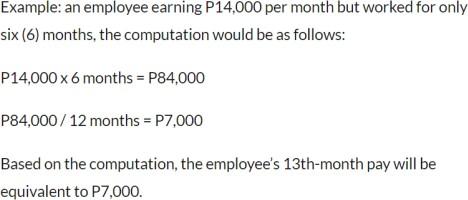
- 13th Month Pay
- Each year, a 13th month pay is required to be given to all rank-and-file employees
- Managerial employees are exempted from this
- By law, this benefit must be paid in full before December 24th and is mandatory
- Some companies split the payment in half
- First half will be paid in May, while the second half will be given before Christmas
- Employees who have resigned or have been disengaged from the company before the payment of the 13th month pay are still entitled to it in proportion to the length of time they worked for during that year
- Separation Pay
- Following the Labor Code of the Philippines, articles 283 and 284 state that an emplyee can claim separation pay if his contract is ended under authorized causes
- Reasons for termination are not the employee’s fault or doing
- Some companies may try to make it seem like their employee was removed for a just cause, when in reality, they do not want to pay separation pay
- According to article 282, an employee terminated for just cause (disobedience, gross and habitual neglect of duty, fraud or willful breach of trust, commission of a crime against the employer or his family) is generally not entitled to separation pay
- It is justified why these employees were terminated from the job
- Separation pay may be computed based on the terms provided in the employment contract, company policy, or collective bargaining agreement
- Company practice may likewise be used as basis for computation, if such practice has been established for years and has already ripened into a demandable right
- In the absence of contract or agreement, or when the existing agreement or policy provides for a lower benefit, separation pay shall be computed based on the provision of the Labor Code
- Reasons for termination are not the employee’s fault or doing
- The amount of separation pay depends on the cause of termination
- If the termination is due to the installation of labor-saving devices or redundancy (e.g., replacing employees with machines that perform the same function as the incumbents), the separation pay is one-month’s pay for every year of service or one month pay, whichever is higher
- If the termination is due to retrenchment (e.g., removing people to avoid the business from closing) to prevent losses, or closure or cessation of operation of the establishment not due to serious business losses, or due to disease, the separation pay is one-half month’s pay for every year of service or one-month pay, whichever is higher
- There is no requirement for separation pay if the closure of the business is due to serious business losses
- Retirement Pay
- All employees from the private-sector may retire from age 60 up to age 65, at which retirement becomes compulsory
- Retirement pay is entitled to those who have served the establishment for at least 5 years
- Retirement pay must at least be equivalent to half of a month’s salary for each year of service and a fraction of at least 6 months is therefore considered as one whole year
- Ex.: If an employee worked for 20 years, they would receive retirement pay equivalent to 10 months' salary for each year of service
- Additionally, if an employee worked for 5 years and 7 months, they would be considered to have worked for 6 years for the purpose of calculating retirement pay, as the policy treats fractions of 6 months or more as a full year
- Minimum Retirement pay = Latest daily pay rate x 22.5 days per month x number of years of service
- De Minimis Benefits
- To reward employee performance and to set incentives that are exempt of taxes under certain conditions
- Following the tax code, benefits received are excluded from the computation of gross income as long as it remains below P30,000
- Non-taxable but should not exceed Php 30,000
- “Gross benefits” include: the 13th month pay, Christmas bonuses, productivity and incentive bonuses, and other benefits of the same nature in cash or in kind
- De Minimis Benefits have the purpose to promote the well-being and efficiency of employees and are limited to facilities or privileges of relatively small size
- De Minimis Benefits include
- Each year, a 13th month pay is required to be given to all rank-and-file employees
*These do not need to be reimbursed
- Medical cash allowance to dependents of employees, maximum of P750 per semester or P125 per month.
- Rice subsidy, up to P1,500.
- Uniform and clothing allowance, up to P5,000 per year.
- Actual medical benefits, up to P10,000 per year.
- Laundry allowance, up to P300 per month.
- Employee achievement awards (loyalty reward, safety reward) in forms other than cash or gift certificates, and in a maximum value of P10,000 per year in accordance to an established plan which does not discriminate to favor highly paid employees.
- Gifts given for Christmas, special festivities or special circumstances (marriage, illness…)
- Cannot be over P5,000 per employee per year
- Daily meal allowances during overtime work must not exceed 25% of the basic minimum wage
- Social Security System (SSS)
- Source of retirement money; a way for someone who has retired to earn income
- By law, private sector employees must be covered under the Social Security System (SSS)
- Based on each employee’s gross monthly pay, both the employer and employee remit monthly contributions to the SSS
- In turn, the SSS benefits cover maternity, retirement, sickness, disability, death and pension benefits
- Even if you give to the SSS at least once, you still get benefits
- Employer share: 9.5%
- Employee share: 4.5%
- Under R.A.No. 10361 or the Batas Kasambahay, the employer pays the entire contribution if the kasambahay earns less than Php 5,000 per month